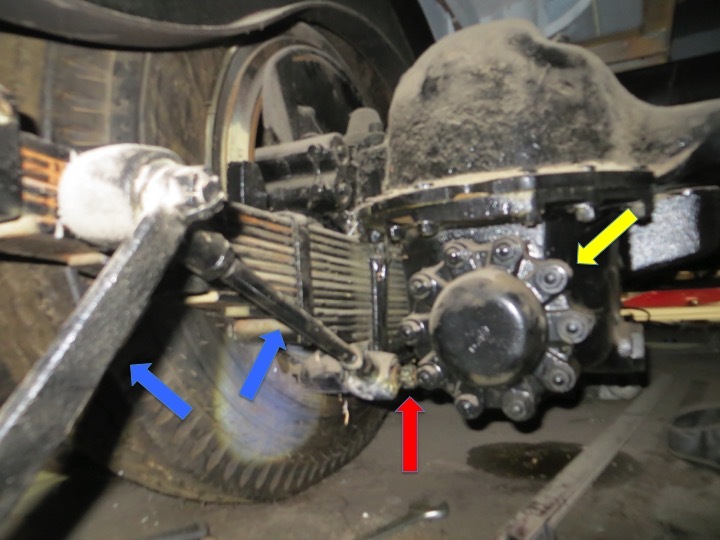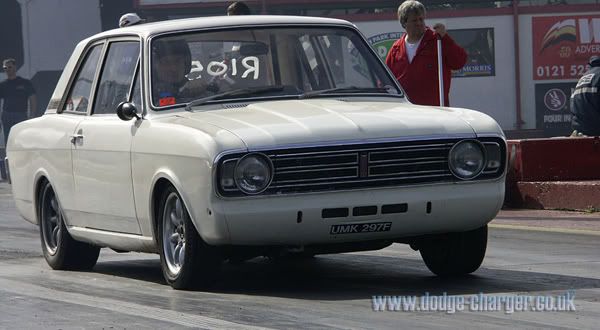|
|
|
Sept 15, 2019 19:20:58 GMT
|
I walked into the office at South East Coachworks (hereafter called SEC). “Hi, I’m James, I’m here to meet Ian from the Friends of Chatham Traction.” “He’s in the garage, you can’t miss him, he’s really tall.” So I signed in and they took me through and introduced us. I’m 6 foot or there abouts and Ian is notably taller than me. Allow me to introduce him to you all…   Well that’s his feet. He’s so tall he’s actually working on the clutch at the front.  Before we move on I’d like to point out a couple of things in this photo. Firstly, if you get involved with a vintage bus this seems to be a common, fairly unpleasant and extremely filthy position you’ll spend a lot of time working in. Now, look at the profile at the bottom of the sides. It’s got that beautiful Coke bottle curve and flair at the bottom. Eastern Coach Works bodies of the period were more straight sided. The curve seems to be a feature of the Weymann body. You might not be able to see it but there is also a convex section running under the windows that ends on the last bay (the one without a window because that’s where the stairs are. Anyway, because of the curve in the bottom of the panels that corner panel isn’t just a flat panel bent round the corner. I have no idea how they made it but it’s really stunning. See, buses can be beautiful too. Anyway, this is supposed to be a moan about spanners… Ian said “Oh it’s all Whitworth bolts by the way.” Fair enough. Part of my inheritance from my late farther was his old tool box mostly full of random imperial spanners. They’ve sat in the loft in the garage for years (I’m so posh I have a loft in the garage) but now they could be useful. Great. For a lot of reasons it seems appropriate to use his old tools again. Better sort them out and see what I’ve got.  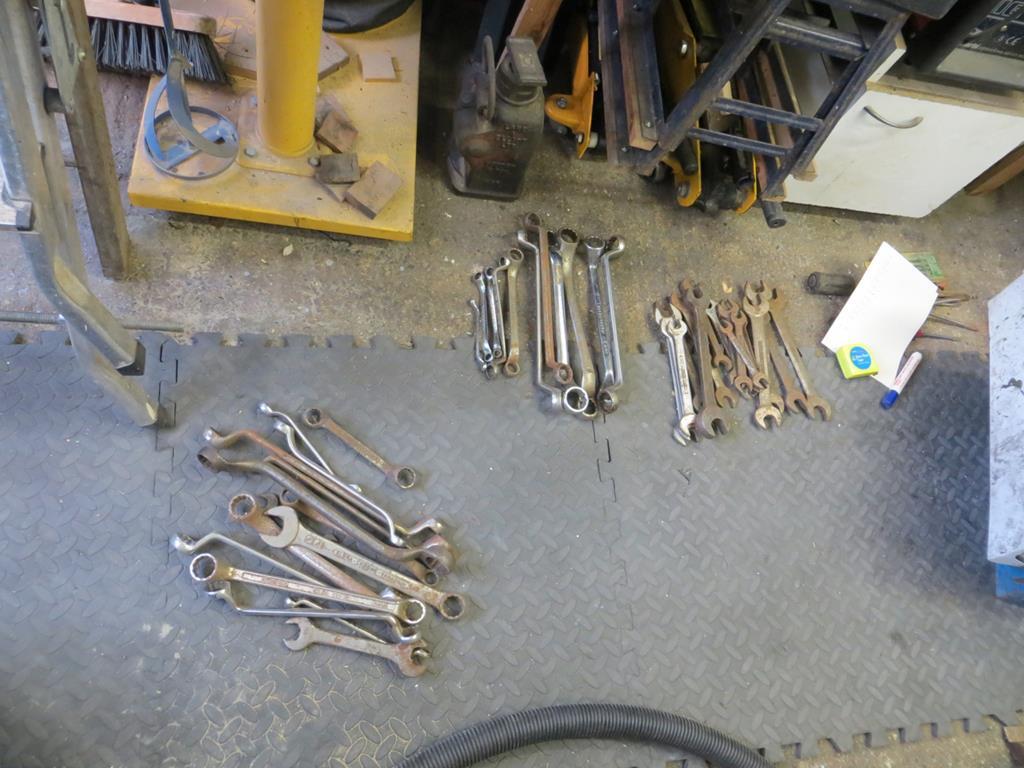 I should point out that I’m of that age where I learned metric at school but dad used imperial. So I’m in the happy position where I can use Meters and Centimetres or Feet and Inches. Or occasionally a perverse mixture of both - “3’ 7” + about 4mm”. It’s one of the great joys of being however old I am. What I’ve never practiced is fractions. So I know without thought that 16mm is bigger than 13mm but I have no innate sense of whether 3/16” is bigger or smaller than 1/4”. I can work it out but I don’t just know. And then we have Mr Joseph Whitworth. Before about 1840 there were no standards for nuts and bolts. So while one manufacturers nut would fit his bolts God help you if you tried to put it on a bolt from somebody else. Whitworth came up with the first national standard. Thread pitch, angles, even how big the nut would be for a particular diameter of shank. So spanners were marked with the diameter of the bolt shank because from that you’d know how big the nut was across the flats. It’s in the standard. The man was undoubtedly brilliant and should be celebrated with an annual day off work. However, my dear children, then it evidently went a bit wrong. Somebody decided that you didn’t necessarily need a nut that big and started making them one size smaller. And then during WW2 the idea became almost standard apparently to save metal. So some of dad’s spanners are marked Whitworth (big nuts) and some are marked BS (small nuts). Some are marked with both. Sometimes they don’t tell you what the markings are. Some are perversely marked AF (across the flats). Some are marked in imperial and mm for goodness sake! And one seems to be marked with something totally random ‘cos it doesn’t marry up with any of the above. Damn it Janet! How’s a man supposed to put together a set of spanners when you don’t know what all the numbers mean… And I have no idea if any of them are ‘bus sized’. |
| |
Last Edit: Sept 15, 2019 19:23:32 GMT by Sweetpea
|
|
|
|
goldnrust
West Midlands
Minimalist
Posts: 1,887
|
|
Sept 15, 2019 19:38:57 GMT
|
|
Having grown up on millimetres, and only in the past couple of years owned vehicles which need imperial spanners I know what you mean about not instinctively knowing which size is which. As you say you can relatively easily work it out, but its that sort of muscle memory of "1/2" is too small, I need a 9/16" that you've gotta learn.
I've no idea about anything bus related, but a good bit of old fashioned 'big' engineering is always interesting. I look forward to more!
|
| |
Last Edit: Sept 15, 2019 19:39:30 GMT by goldnrust
|
|
|
|
|
Sept 15, 2019 20:31:11 GMT
|
If you've ever worked on Minis - older ones - then you soon get your head round 1/2" and 9/16"!  A lot of jobs on them can be done with that one spanner. |
| |
1968 Mini MkII, 1968 VW T1, 1967 VW T1, 1974 VW T1, 1974 VW T1 1303, 1975 Mini 1000 auto, 1979 Chevette, 1981 Cortina, 1978 Mini 1000 1981 Mini City, 1981 Mini van, 1974 Mini Clubman, 1982 Metro City, 1987 Escort, 1989 Lancia Y10, 1989 Cavalier, 1990 Sierra, 1990 Renault 19, 1993 Nova, 1990 Citroen BX, 1994 Ford Scorpio, 1990 Renault Clio, 2004 Citroen C3, 2006 Citroen C2, 2004 Citroen C4, 2013 Citroen DS5. 2017 DS3 130 Plenty of other scrappers!
|
|
eternaloptimist
Posted a lot
   Too many projects, not enough time or space...
Too many projects, not enough time or space...
Posts: 2,578
|
|
Sept 16, 2019 5:18:14 GMT
|
|
Whitworth and A/F spanners are different - if the bus uses Whitworth, you shouldn’t need the A/F. Remember when you thought learning about fractions was pointless? This is when you need to be able to figure out 1/2 is the same as 8/16 so a 7/16 spanner is the size smaller than a 1/2 spanner, a 9/16 is the next one up followed by a 5/8. That’s pretty much 80% of what you need working on a 50’s/60’s British car.
Cool bus btw, looking forward to this.
|
| |
XC70, VW split screen crew cab, Standard Ten
|
|
|
|
|
Sept 16, 2019 6:08:15 GMT
|
|
Nowt wrong with a proper people carrier - I have had a hand in several classic / vintage buses & coaches over the years and given the chance would have another one tomorrow - however you need lots of undercover space and they are has already explained genuine money pits - still love to see them though and there is a great sense of satisfaction in bringing one back from the dead - regardless of if you own it or not
|
| |
|
|
jamesd1972
Club Retro Rides Member
Posts: 2,921  Club RR Member Number: 40
Club RR Member Number: 40
|
|
Sept 16, 2019 6:53:37 GMT
|
|
I've had to enter the world of whitworth spanners as well, the gearbox in the Land-Rover being a 1930's design uses them. The rest of the car is imperial AF spanners. Well apart from the bits that have been rebuilt with metric. Its a joy to work on in that way...
Anyway the one good thing about whitworth (other than stronger threads than metric ones) is that the local FB / Gumtree / Preloved pages are full of shed clearance tools and the non-metric ones are usually cheap !
The other thing I learnt somewhere on this forum is that traditional whitworth spanner sets would come as one set of ring spanners and one set of open ended in matched sets. How else are you meant to undo a nut and bolt ? Can't do that with one of those pesky modern combination spanners.
Anyway that bus does look lovely, I can see your skills being put to good use !
James.
|
| |
|
|
|
|
|
Sept 16, 2019 6:57:22 GMT
|
You never have time to restore an MR2 let alone a bus!  In for updates, hopefully I can keep up with this one... |
| |
|
|
|
|
|
Sept 16, 2019 12:08:53 GMT
|
|
The morris minor has quite few whitworth fastners as well, I was given a brand new set of spanners colleague had never used.
I believe bsf (british standard fine) uses the same spanners as bsw.(british standard whitworth)
|
| |
Last Edit: Sept 16, 2019 12:12:47 GMT by kevins
|
|
|
|
|
Sept 16, 2019 12:37:57 GMT
|
|
These are the type of buses I used to take with my mum through Manchester and then to school.
It was the thrumm, thrumm* of the engine that I remember above all else.
So looking forward to this.
*Other noises may apply.
|
| |
|
|
|
|
|
Sept 20, 2019 0:09:11 GMT
|
|
I remember the "Decimilization, Decimilise" jingles on British telly when the currency went metric.
Here in the US, cars are now built with metric fasteners but the construction trade remains all in inches, which I rather like because the fractions make me think a bit more, having to do calculations...a much needed excercise. Yes, metric is much easier. I also like the fact Americans have stuck with miles over kilometers. Why? I was raised with miles and remember the distance signs on the M4 from Bristol to London...familiar.
That bus repair depot film blew my mind....thanks for posting it. What a rotisserie! Seems to me like a great example of what's possible when Quality is the goal, as opposed to the darker aims of Efficiency and Short Term Gains. WW2 production engineering know-how. Great project. John.
|
| |
|
|
|
|
|
|
|
Sept 21, 2019 17:55:20 GMT
|
Sorry folks. We've had 'issues' (as they say at work) at my house. I've not been ignoring you all. We are not allowed to have breakdowns or faults or cockups at work. You have 'issues' instead. Anyway, Yeah... I'm new to this imperial spanner malarkey I strongly suspect that it'll be 'resolved' ('cos you aren't allowed to 'fix' things either...) by using the words 'bigger' and 'littler' ('cos, in a last ditch stand against being told what to call things I'm refusing to use the correct word 'smaller'). "Nah, it's littler 'an that." Sounds better than. "I believe we can resolve the issue by using a tool smaller than the one currently in my possession." Well, I think so anyway. You never have time to restore an MR2 let alone a bus!  When I was talking to the chaps a year ago I thought exactly that... Oh well, too late now! I wasn't actually sure how this thread would be received. After all it's not really the stock-in-trade of this site. And, worse still, it's a bus. Now just because I happen to have a thing for a half cab double decker I wasn't sure what you folks would think. So thank you all for your positive comments. I do appreciate it! James |
| |
|
|
|
|
|
Sept 21, 2019 19:00:23 GMT
|
|
In for the journey sir!
See what I did there??......
|
| |
|
|
|
|
|
Sept 21, 2019 21:48:55 GMT
|
I should apologise, I didn’t take many photos this time. And what I did take were rubbish. I promise to do better in future. So the first time I met Ian and actually got my hands dirty the job was to get the shocks off for refurbishment. By the way, if you want your hands stupendously dirty, play with a bus. Er, no, the shocks aren’t like the ones on your car. Have a diagram.  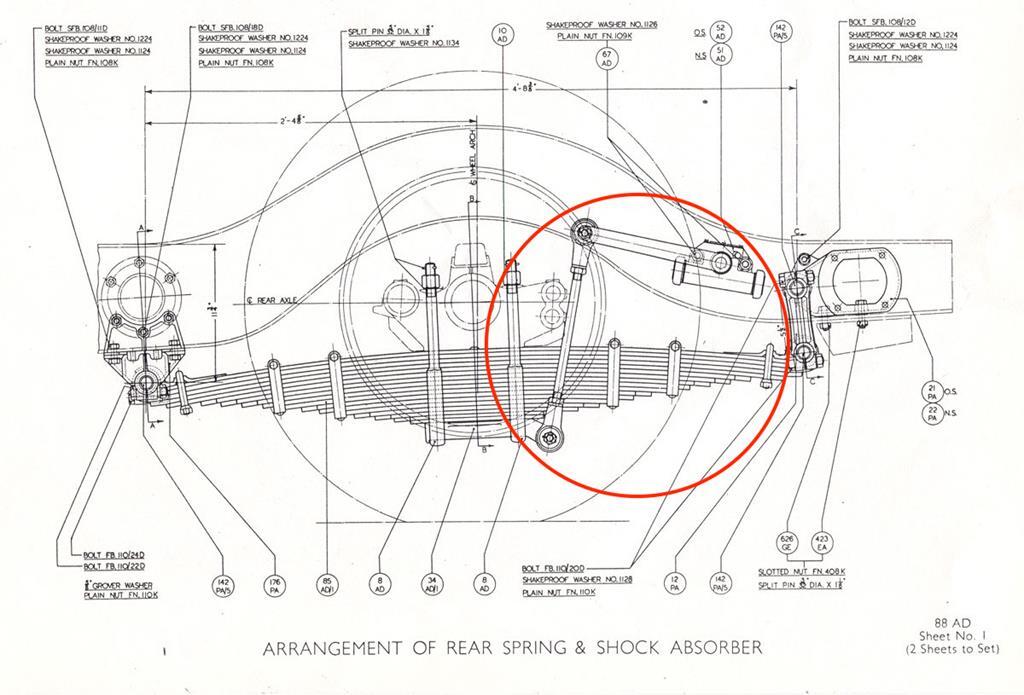 I suppose they might be like the ones on your car if you have a really old car. Just how effective these things are has to be debatable. Ian reckons there probably isn’t a lot of movement in the springs anyway and most of the ‘ride’ is in the sidewalls of the tyres. Safe to say this isn’t your modern, air sprung bus. People were clearly tougher in 1939. And if they weren’t, they would be when the war ended a few years later. One of the front shocks had been removed some time ago as I believe one of the arms was bent. Ian had taken the other front one off when I turned up to slow the procedure down. “Have a spanner” he said and indicated that I’d find the shocks by sliding under the old girls skirt. Ok. Thrown in at the deep end then. Learning on the job. I can go with that. That said, you don’t need to be too portly for this. There isn’t a great deal of space to slide under the side. Luckily Mrs Sweetpea keeps me on a strict diet of raw carrots. So, one castle nut and and split pin at the spring end and a couple of nuts and bolts at the chassis end. Of course the split pin wouldn’t come out of the right side so we wound the nut over the top and will have to clear the hole out later. A bit evil I know. But this thing is big so shearing the pin off with the nut isn’t a disaster. And, of course, I was too much of a girl to get the nuts undone ‘cos they are stupidly tight. Eventually, by twisting myself round I could get my foot on the spanner. Right side done, we moved to the left and ran into a problem.  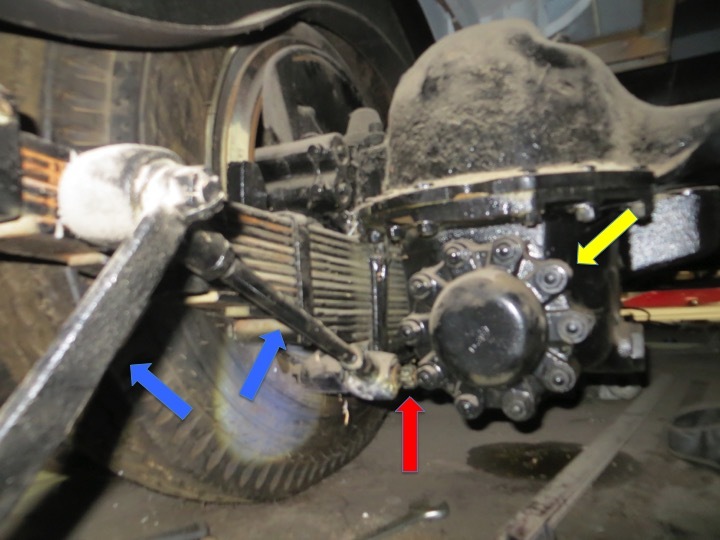 Sorry that photo is just rubbish but it’s the only one I have. Once you’ve slid under the side there is a surprising amount of room under here. I can sit in a hunched cross legged position. The shock has been unbolted from the chassis and you can see the two arms (blue arrows) coming off the the left of the photo. The red arrow is the castle nut (the split pin did come out of this side). And at the joints are rubber bushes that have failed and need replacing. The diff is offset to the left side of the bus and is hard against the spring presumably to keep the floor as low as reasonably possible in the middle. It’s also not a hypoid gear set on the input to the diff. The drive shaft comes under the diff and is a worm and gear type. The spider thing that the yellow arrow is pointing at is the casing of the rear bearing of the input shaft. Guess what. Yup, it stops the shock bush sliding off the pin on the spring plate. Hmmph. About this time, as I was sitting under the bus wondering what to do next, I realised that when I looked up I could see light through the floor. Hurray! There is an access hatch in the floor! I gave it a push and it popped out. There was a loud clatter from the Henry hoover that was on top of it as it fell onto the back platform. But hell, no more sliding under the side. Since the rubber of the bush had come away from the inner crush tube we could slide the tube out and remove it by cutting it into sections. That gave us just enough wiggle room to twist the lower joint off the pin. Hurray! However to put it back on we are going to have to dismantle the U bolts (which I don’t think are U shaped) and remove the lower plate. Apparently that’s not an easy job. That said, Ian suspects that the spring shackles are sloppy too in which case a lot of the suspension will have to come apart anyway. That’s probably not an easy job either. James |
| |
|
|
jpsmit
Posted a lot
  
Posts: 1,274
|
|
Sept 22, 2019 2:44:53 GMT
|
I'm envious! Love the idea of working on a bus - doubly so when it is someone elses.  Level shock - pah - 1976 Midget. |
| |
|
|
|
|
|
Sept 22, 2019 16:48:50 GMT
|
Sweetpea, From the tasks you've demonstrated in your "avoidance" thread, I thought we'd first see you redoing the steps to the upper level...  Concerning this: Would supporting the frame, then loosening the leaf spring connections to the differential and jacking the differential up allow clearance for reinstallation of the shock? Just a thought, Lance |
| |
|
|
|
|
|
Sept 22, 2019 20:41:20 GMT
|
Dunno if it's just me but I'm having real bother with quoting people... And Bookmarks and Profile for that matter. Anyhoo... jpsmit , 1976 Midget? Really... Blimey. I stand corrected on the 'very old' thing... strangersfaces , I think that would roughly be the plan. But actually doing it may not be so simple. Firstly (and I'm guessing here...) I had to put my feet on the spanner to undo the shocks. The nuts on the ends of the U bolts are going to be seriously tight. And probably not easy to get to. And secondly the U bolts are the other way up to the way you'd find in a car. The U bit (if it is even a U) goes under the spring and the bolt ends go up through the casting that forms the end of the axle. As such they go through quite a long hole so I reckon they could be tricky to get back out after 80 years. It's not going to be a "knock the nuts off and the U bolts drop off with a sharp tap with a hammer" sort of job. If Ian doesn't get fed up of me slowing him down and keeps inviting me to 'help' then we'll all find out one day! |
| |
|
|
bstardchild
Club Retro Rides Member
Posts: 14,968
Club RR Member Number: 71
|
|
|
|
|
I am certain you are certifiable
Booked and Marked for the journey as I can't see this slowing down the progress in the M R D
|
| |
|
|
|
|
|
|
|
I am certain you are certifiable Welcome along for the ride! (See what I did there? It's a bus. Ride, geddit? Oh never mind... Wasn't actually funny.) Yeah, I've not asked about that ^ on grounds that you may be right. There is an update to come. Stuff I did before our world got turned over and didn't get round to writing it up. |
| |
|
|
v8ian
Posted a lot
  
Posts: 3,832
|
|
|
|
It’s about time we had another commercial on here. The bus…
It’s a 1939 Bristol K5G fitted with a Weymann body and caries the registration GKE 68. If you happened to live in Chatham in Kent just before the war (there won’t be many of you) your local bus operator was a company called Chatham Traction. Well this is the only surviving Chatham Traction bus. All the rest have gone to make bean cans. As such it’s unique. It’s also unusual because of the Weymann body. Most Bristol service busses had Eastern Coach Works bodies fitted. As an operator you bought your chassis and chose who’s body to put on it. For some reason Chatham Traction went for Weymann over ECW. Over the years since it was withdrawn from service a few enthusiasts have realised the importance of this last remaining Chatham Traction bus and it was saved from the scrap yard but it became increasingly derelict. As far as I can see no individual had the time or resources to restore the old girl and at one point she wound up in a garden with a tarpaulin tied over the top. I’m told that owning a bus is second only to owning a boat as a route to financial destitution. Thank God it’s not mine. Around 2007 a charity was set up (Friends of Chatham Traction) with the aim of saving GKE 68 and with the aid of some grants and lottery funding they have slowly been plugging away at it ever since. Me and my interest in it…
Ok so I’ll admit that as a bus freak I’m a rubbish one. Sorry, I feel I’ve let you all down there with my lack of dedication. I have a thing for old commercial vehicles and double deckers in particular. (There is a reason for that but it’s a story for another day). But busses in general… Well I used to travel on the bendy busses in London and generally they smelt of tramps and diesel and sounded like the wheels could fall off at any moment. Unimpressed. But a half cab double decker. Oh. Baby… Come to daddy! I bumped into GKE 68 just over a year ago. There is a transport weekend in town each year - old cars, trucks and busses. GKE 68 was sitting in the corner of a coachwork company in town. Given my thing for a half cab double deckers I wandered over and asked what it was. The chap was sizing me up. Does he want the answer “It’s a bus sir” or is he a bus nerd who wants a proper answer? Anyway I offered my services bolting it back together while wondering if I really needed another project. It’s not like I haven’t enough to do. We kept in touch during the year but nothing much happened until the next transport weekend when I dropped in again. It was still in the corner of the garage and didn’t look a lot different to be honest. This time, instead of standing politely talking, I met a few of the people involved and was then I was on my knees looking underneath her. And shortly after that I was emailing a chap called Ian making arrangements to have a day with the spanners. Oh spanners… Whitworth spanners. Dear God. There is a rant coming up! James Anybody who grew up in South East London in the 70s will remember Margoes coaches, they were a company who rented out coaches and Busses to schools for going to sports fields and events out, They had a Rag Tag assembly old decrepit fleet mostly of 40s and 50s double deckers still in the original company liveries and the company name brush painted over, and an old numberplate in the window saying MARGOES and a Margoes designation, I still remember going to school games on a Bristol LowDecca in Ribble Vally Colours, they had seemingly 100s of old busses at their disposal,Magic Times |
| |
Atmo V8 Power . No slicks , No gas + No bits missing . Doing it in style.
Austin A35van, very different------- but still doing it in style, going to be a funmoble
|
|
|
|
|
|
|
|
Not sure much has changed. Old service buses are pressed into service to run rail replacement services and such like. I've been on a few when the railway got dug up at the weekends.
As an aside, I notice Wrightbus in Ballymena went bust. I know very little about the subject but I've read enough to believe that some operators are struggling and I guess its now translating to the manufacturers.
I'm not actually sure who's left. Alexander Dennis, but I'm not sure who else.
I went to Belfast earlier this year and loved it - but then Harland and Wolff went bust. I believe they were recently bought for peanuts so there may be some life left there. But between H&W and Wrighbus it does make you worry about the UK's manufacturing industry and particularly in Northern Ireland.
Anyway, a short video...
For the last 'transport weekend' GKE was rather hidden in the back of the South East Coachworks garage. It needed to be moved forward a little to make it more visible.
Easy. Start it up and drive it forward. Except the engine isn't plumbed in and the gearbox isn't even in the same town.
So how do you move 7 or 8 tons of bus that has no motive power?
Well it turns out this is an old school problem. Bus maintenance workshops would have had the problem of shifting dead buses around since the day bus was invented. So there is an old school way of doing it.
You'll like this...
|
| |
|
|
|
|












 A lot of jobs on them can be done with that one spanner.
A lot of jobs on them can be done with that one spanner.



